![]()
Aroids and other genera in the Collection
Take the Tour Now?
Orchids
The
Exotic Rainforest
Plants in
the Exotic Rainforest Collection
The images on this website are copyright protected. Please contact us before any reuse.
Within our collection we have many species of Philodendron.
If you are seeking other photos,
click this link:
Philodendron
martianum
Engl.
Incorrectly known as Philodendron cannifolium Mart.
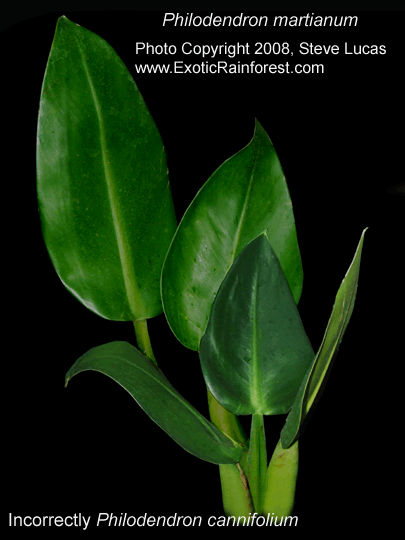
Incorrectly known as Philodendron cannifolium
The name "Philodendron cannifolium" is considered illegitimate by
the Royal Botanic Garden Kew In London
Common Names: von Martius' Philodendron, Flask Philodendron,
sometimes called "Philodendron Katak" and Philodendron Fat Boy in SE Asia
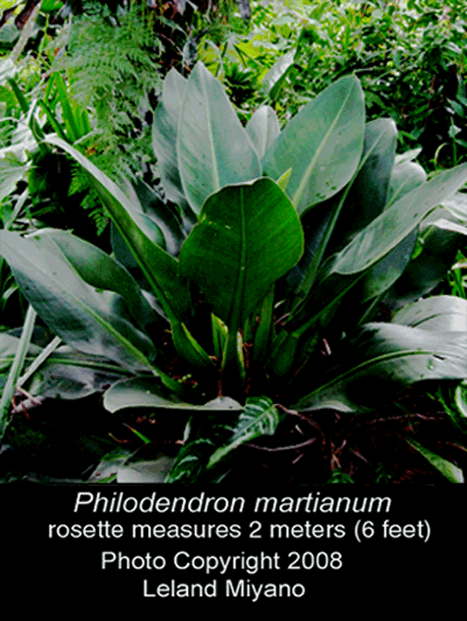 Philodendron
martianum is endemic to (exclusively found in) Brazil and was
described to science in 1899 by botanist Heinrich Gustav Adolf
Engler (1844 to 1930).
Adult specimens of Philodendron martianum grow in a
rosette form (similar to the arrangement of a rose's petals) and are
capable of growing quite large (2 meters or more) as can be seen in Leland Miyano's three
photos on this page. Leland reports having seen specimens in
Brazil that were even larger. The species grows
as an epiphyte (ep-a-FIT) on the branches of trees as well as a
terrestrial species provided the host tree falls. An epiphyte is a plant
that grows upon another plant and the seeds of epiphytic species are
distributed among a tree's branches in the droppings of a rain
forest bird or animal that has eaten the ripe berries containing
seeds produced by
the aroid's inflorescence. An explanation of an aroid inflorescence
including a photo of the spathe and spadix of Philodendron martianum can be found later in this article.
Philodendron
martianum is endemic to (exclusively found in) Brazil and was
described to science in 1899 by botanist Heinrich Gustav Adolf
Engler (1844 to 1930).
Adult specimens of Philodendron martianum grow in a
rosette form (similar to the arrangement of a rose's petals) and are
capable of growing quite large (2 meters or more) as can be seen in Leland Miyano's three
photos on this page. Leland reports having seen specimens in
Brazil that were even larger. The species grows
as an epiphyte (ep-a-FIT) on the branches of trees as well as a
terrestrial species provided the host tree falls. An epiphyte is a plant
that grows upon another plant and the seeds of epiphytic species are
distributed among a tree's branches in the droppings of a rain
forest bird or animal that has eaten the ripe berries containing
seeds produced by
the aroid's inflorescence. An explanation of an aroid inflorescence
including a photo of the spathe and spadix of Philodendron martianum can be found later in this article.
The following information regarding where and how Philodendron martianum grows in nature was provided by aroid botanist Marcus A. Nadruz Coelho, Diretoria de Pesquisas, Instituto de Pesquisas Jardim Botanico do Rio de Janeiro (Rio de Janeiro Botanical Garden) in Brazil. The restinga is a unique coastal tropical and subtropical moist rain forest habitat and includes the coastal sand plains along the southeastern Atlantic coastline of Brazil. Marcus wrote in a personal communication in September 2008, "Philodendron martianum is a species that occurs in the Atlantic rain forest and forest of restinga (not in vegetation of restinga). This species prefers shaded places and is found up to 900 m (2,950 feet) in altitude. It has distribution in Santa Catarina, Sao Paulo and Rio de Janeiro but the populations are more numerous in the State of Rio de Janeiro by having more mild temperature between 20 and 35 degrees Celsius (68 to 95 degrees F) and is more common in forests near the sea. The possible record for the Bahia may be a mistake, that material must be considered. It is predominantly epiphytic but is on the ground optionally when a tree falls."
Friend and aroid expert Leland Miyano (who has
spent a great deal of time in the rain forests of Brazil) also commented,
"I grow mine as both
epiphytes and terrestrials. However, in habitat I have only seen
them as epiphytes...quite large and heavy on smallish trees with
rather open canopies and associated with Bactris palms. When I grow
them as epiphytes they are slower
and smaller. As terrestrials,
they grow faster and larger. In fact, my largest plants have leaves
3 feet total length...2 foot blades
with 1 foot petioles. (.9 meters x .6 m x .3 m)
They do
not like to be too wet so maybe this is why in a seasonally flooded
restinga,
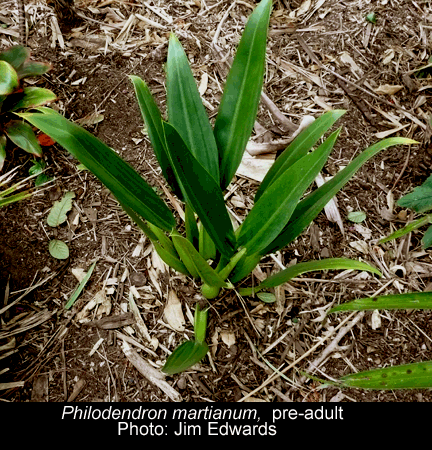 I only saw them as epiphytes. The habitats I have
seen them in are coastal restingas as epiphytes in stunted trees
with swampy ground...not really dry areas...but these restingas may
be seasonally dry areas."
Leland's hand in the photo below measures almost 18cm (7 inches).
I only saw them as epiphytes. The habitats I have
seen them in are coastal restingas as epiphytes in stunted trees
with swampy ground...not really dry areas...but these restingas may
be seasonally dry areas."
Leland's hand in the photo below measures almost 18cm (7 inches).
For many years the correct name
for Philodendron martianum (the species seen on this page) has been incorrectly identified by
a few scientists and commonly by plant collectors. On
plant auction sites Philodendron martianum is frequently sold as
Philodendron cannifolium which is either an
inaccurate scientific name or a completely different species
that does not resemble
Philodendron martianum. If you were to go to the
Missouri Botanical Garden site TROPICOS you will understand how
this error persists.
Tropicos NameSearch Philodendron+cannifolium
Once you click this link you'll arrive at a page for Philodendron
cannifolium Once you're there you will find three dates of
publication: 1839, 1841 and 1899. Click on each of the three names
and you'll find that species truly refers to either Spathiphyllum
cannifolium or Philodendron rudgeanum (click on synonyms).
The name Philodendron cannifolium is not an accepted scientific
name and does not apply to the plant being discussed here. An
explanation follows.
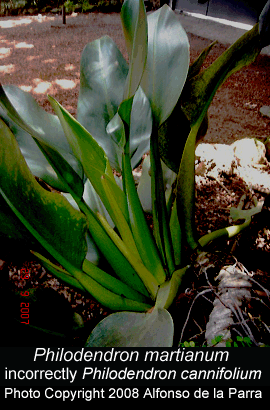 The most
authoritative source for scientific species' name information is the Royal
Botanic Gardens Kew in London since all species names must be
verified through their resources. The Kew has a variety of websites
including the International
Plant Names Index, the Kew World Monocot
Checklist and others. On these scientific databases you can
find the accepted name for the species shown here is correctly Philodendron martianum.
If you type in the name Philodendron cannifolium you will also find
(even though it has been published) the name is illegitimate
under botanical rules and
was published in contravention to the rules
for valid publication. Royal
Botanical Garden Kew, London
The most
authoritative source for scientific species' name information is the Royal
Botanic Gardens Kew in London since all species names must be
verified through their resources. The Kew has a variety of websites
including the International
Plant Names Index, the Kew World Monocot
Checklist and others. On these scientific databases you can
find the accepted name for the species shown here is correctly Philodendron martianum.
If you type in the name Philodendron cannifolium you will also find
(even though it has been published) the name is illegitimate
under botanical rules and
was published in contravention to the rules
for valid publication. Royal
Botanical Garden Kew, London
How is such an error possible? Please remember when those early botanical descriptions were published in the 1800's botanist did not have access to the internet, a computer, telephones, or rapid communication. Frequently they did not have access to all the previously published works of botanical science, especially while in remote tropical rain forest regions. Many were forced to simply work from memory when in the field. Verifying whether or not a specimen was previously described often required creating a drawing, attempting to collect a living specimen or dried material before traveling by a slow ship back to Europe in to verify a name. As a result, it was not uncommon for names to be used more than once to describe different plants or for a species to be described in the wrong genus. However, within the rules of botanical science the first date of publication of a scientific name that is correct to genus becomes the accepted name for that species and all others become a synonym provided they were describing the same species.
The following explanation is likely to be confusing to those who do not normally read botanical scientific literature. Please read it through slowly or more than once and you will understand that Philodendron cannifolium is a very different plant than Philodendron martianum.
The name Philodendron cannifolium
has been published to science three different times and each time
the name was
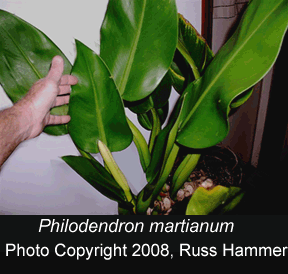 used for a different plant or was used illegally
according to the rules of botany to describe an already existing species. (You
may verify this fact via the
Kew World Monocot Checklist website). Here are the
dates and authors who described plants using the name
Philodendron cannifolium:
used for a different plant or was used illegally
according to the rules of botany to describe an already existing species. (You
may verify this fact via the
Kew World Monocot Checklist website). Here are the
dates and authors who described plants using the name
Philodendron cannifolium:
Philodendron cannifolium (Dryand. ex. Sims) Sweet (published in 1839) is not a Philodendron but is a Spathiphyllum species correctly known as Spathiphyllum cannifolium. As a result, that name is incorrect and stated by the Kew to be illegal.
Philodendron cannifolium Mart. ex Kunth (published in 1841) was incorrectly indicated by Dr. Carl Friedrich Phillip von Martius M.D. (1794-1868) in his Flora Brasiliensis Volume 3 when he published an exquisite drawing of Philodendron martianum and called it Philodendron cannifolium in error. Therefore, that use of the name is also incorrect and the use is noted by the Kew as illegal.
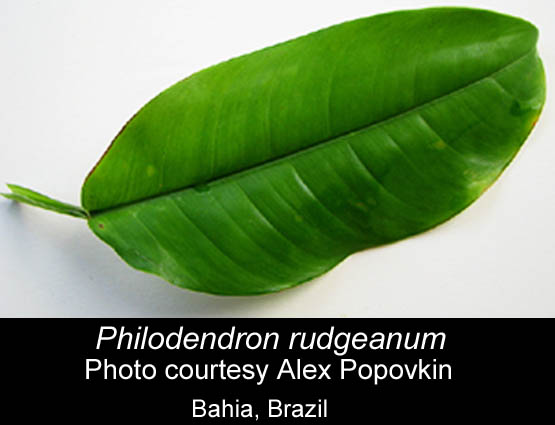
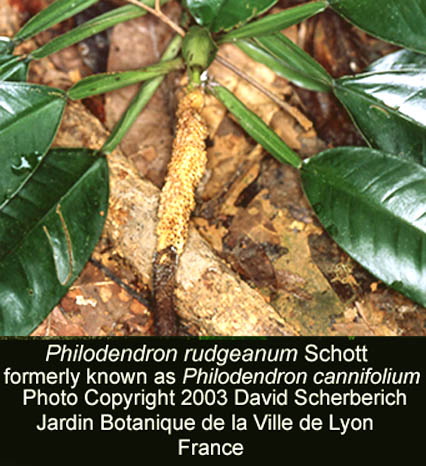 The
third publication of the name Philodendron cannifolium Engl.
(published in 1899) is botanically a synonym
for Philodendron rudgeanum Schott. (see photos of that
species on this page) and
is not a synonym for Philodendron martianum.
Philodendron rudgeanum is a vine that possesses leaves that are
similar to a Spathiphyllum.
Philodendron rudgeanum was published in 1856 and is found in
Brazil, French Guiana and Colombia and looks nothing like
Philodendron martianum.
The
third publication of the name Philodendron cannifolium Engl.
(published in 1899) is botanically a synonym
for Philodendron rudgeanum Schott. (see photos of that
species on this page) and
is not a synonym for Philodendron martianum.
Philodendron rudgeanum is a vine that possesses leaves that are
similar to a Spathiphyllum.
Philodendron rudgeanum was published in 1856 and is found in
Brazil, French Guiana and Colombia and looks nothing like
Philodendron martianum.
There is also a fourth
publication which was for Philodendron guttiferum var. rudgeanum
(Schott) A.M.E. Jonker & Jonker published in 1953. The
botanical records are not precisely clear on this publication but that
publication has also proven to be only a synonym of Philodendron
rudgeanum. Although this plant has not been associated
with Philodendron martianum, upon occasion the name has been
confused with Philodendron cannifolium.
Although some websites indicate the
name Philodendron cannifolium is a synonym of Philodendron martianum, if you read the scientific information
found on the Kew's websites you will not find the name P.
cannifolium to be synonymous with Philodendron martianum.
Collectors appear to be using the scientific term "synonym" in a
generic form to indicate the names are used interchangeably by
plant collectors. However, in botany, a synonym is the
republication of a plant
that has been previously published in a scientific journal and then incorrectly
given another name by a botanical author (thus a synonym). Due to the
natural variability of aroid
and other plant species that error was
commonly made during earlier centuries. When multiple publication
of the same scientific name occurs the date of
 earliest publication
becomes the accepted name and the later published name(s) become
the synonym.
earliest publication
becomes the accepted name and the later published name(s) become
the synonym.
So how did this commonly accepted plant myth become popular with
plant collectors? There is a well known plant collector's
guide written
by horticulturalist Alfred Byrd Graf which many refer to as the
"collector's bible". Mr. Graf was not a botanist but set out
with great success to illustrate as many tropical plant species to the
world of plant collectors as possible. Mr. Graf
published a photo of the species Philodendron
martianum but his caption incorrectly called the plant Philodendron cannifolium
(possibly as a result of Dr. von
Martius' illustration in Flora Brasiliensis Volume 3). Unfortunately,
the name used (as well as other photo captions in his books) were not
thoroughly checked by an aroid botanist before the book was both published and republished.
As a result more than a
few of the photos in Mr. Graf's books Exotica and Tropica are
incorrectly labeled. Botanists such as aroid botanist Dr. Thomas B. Croat
Ph.D., P.A. Schulze Curator of Botany of the Missouri Botanical
Garden in St. Louis, MO. have pointed out the correct names in
multiple conversations with serious collectors as a result of Mr.
Graf's unintentional
errors. Still, since plant collectors appear to believe
everything Mr. Graf published these "myths" persist.
As a result of these errors it is more than understandable when a collector elects to put a tag on a specimen of Philodendron martianum and incorrectly call it Philodendron cannifolium since the name has long been confusing. Botanically, the name Philodendron cannifolium is not the same as Philodendron martianum.
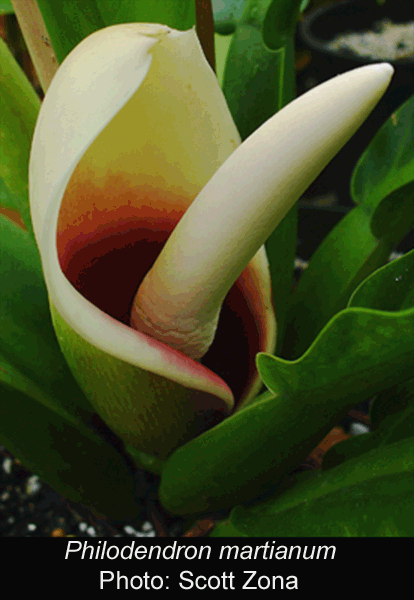 All Philodendron
species are aroids.
An aroid is a plant that reproduces by producing an
inflorescence known to science as a spathe and
spadix which is supported by a peduncle. Once the inflorescence completes sexual reproduce and
the fruit and seed are spread it dies and both the peduncle and
inflorescence drop from the plant which may leave a scar on the
petiole
In the case of older plants,
See Alfonso de la Parra's
photograph (below). Many people believe the spathe is a
"flower" which is incorrect. The spathe is a
specially modified leaf
appearing to be a hood
whose purpose is to protect the spadix at the
center of the inflorescence.
The spadix is a spike on a thickened fleshy axis which can produce
tiny flowers.
On the spadix of
the fertile inflorescence there can be found very tiny
true flowers when the plant is at anthesis (sexual
reproduction). When ready to
reproduce, the spadix produces male, female and
sterile flowers as well as pollen and if the female flowers are pollinated by an
appropriate insect, normally a beetle, they will
produce berries
containing seeds.
Part of nature's plan is to have those berries eaten by rain forest
animals and thus
perpetuate the species throughout the
rain forest.
All Philodendron
species are aroids.
An aroid is a plant that reproduces by producing an
inflorescence known to science as a spathe and
spadix which is supported by a peduncle. Once the inflorescence completes sexual reproduce and
the fruit and seed are spread it dies and both the peduncle and
inflorescence drop from the plant which may leave a scar on the
petiole
In the case of older plants,
See Alfonso de la Parra's
photograph (below). Many people believe the spathe is a
"flower" which is incorrect. The spathe is a
specially modified leaf
appearing to be a hood
whose purpose is to protect the spadix at the
center of the inflorescence.
The spadix is a spike on a thickened fleshy axis which can produce
tiny flowers.
On the spadix of
the fertile inflorescence there can be found very tiny
true flowers when the plant is at anthesis (sexual
reproduction). When ready to
reproduce, the spadix produces male, female and
sterile flowers as well as pollen and if the female flowers are pollinated by an
appropriate insect, normally a beetle, they will
produce berries
containing seeds.
Part of nature's plan is to have those berries eaten by rain forest
animals and thus
perpetuate the species throughout the
rain forest.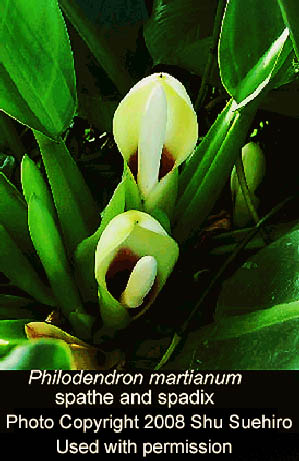 down the "throat". Mine rarely bloom only because I have cut them
so often and only recently let them grow to full size. I also
suspect they like cooler temperatures. Most of the plants I saw
were to the southern end of Rio de Janeiro state and south. That is
not to say they were much farther to north, again these were my
observations and Brazil is a gigantic country to explore."
Philodendron
martianum also reproduces by the production of offsets near the
base of the plant
down the "throat". Mine rarely bloom only because I have cut them
so often and only recently let them grow to full size. I also
suspect they like cooler temperatures. Most of the plants I saw
were to the southern end of Rio de Janeiro state and south. That is
not to say they were much farther to north, again these were my
observations and Brazil is a gigantic country to explore."
Philodendron
martianum also reproduces by the production of offsets near the
base of the plant The petioles (often incorrectly called stems) which support each blade are spongy to the touch and are terete (less than round but still circular or cylindrical). The stems are correctly at the base of the plant which produces the nodes, internodes, buds and thus petioles and inflorescences. To better understand the difference in a petiole and a stem please read this link.
The petioles commonly possess a "C" shaped depression (canaliculate) down the adaxial (upper) surface of the petiole and since the petiole's are often swollen they likely store water or starches inside. There are sharp ridges that define the edges of that canal. See photos of the petioles of Philodendron martianum to the right below.
 Philodendron species are
known to be highly variable and not every leaf of every specimen
will always appear the same. This link explains in
non-technical language natural variation and
morphogenesis within aroids and other species.
Philodendron species are
known to be highly variable and not every leaf of every specimen
will always appear the same. This link explains in
non-technical language natural variation and
morphogenesis within aroids and other species.
Click here.
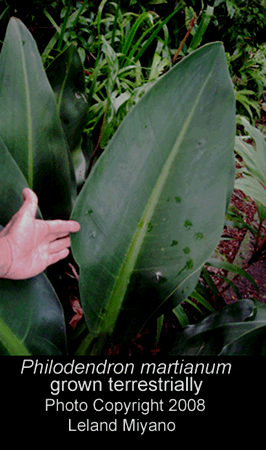
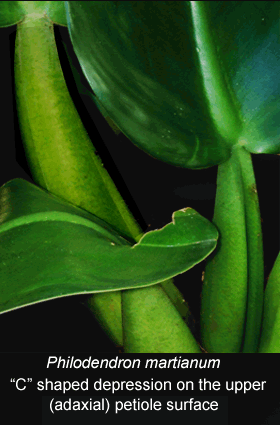
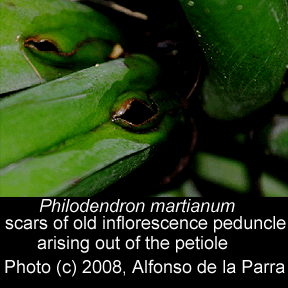
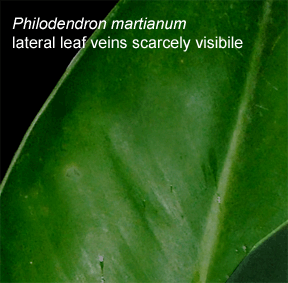
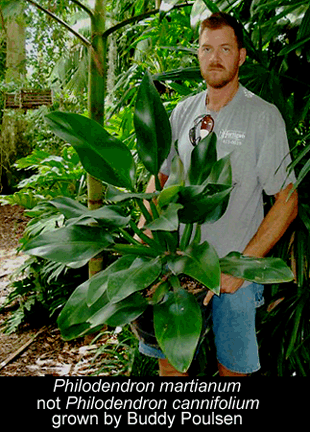
Join the International Aroid Society:
http://www.exoticrainforest.com/Join%20IAS.html
Looking for a specimen? Contact
http:///
:

